https://assets.amuniversal.com/805a8500b5a901396651005056a9545d
Thank you for voting.
Hmm. Something went wrong. We will take a look as soon as we can.
Dilbert Daily Strip
Just another WordPress site
https://assets.amuniversal.com/805a8500b5a901396651005056a9545d
Thank you for voting.
Hmm. Something went wrong. We will take a look as soon as we can.
Dilbert Daily Strip
https://static1.makeuseofimages.com/wordpress/wp-content/uploads/2018/10/conditional-formatting-excel.png
Microsoft Excel formulas can do almost anything. In this article, you’ll learn how powerful Microsoft Excel formulas and conditional formatting can be, with three useful examples.
We’ve covered a number of different ways to make better use of Excel, such as where to find great downloadable Excel templates, and how to use Excel as a project management tool.
Much of the Excel power lies behind the Excel formulas and rules that help you manipulate data and information automatically, regardless of what data you insert into the spreadsheet.
Let’s dig into how you can use formulas and other tools to better use Microsoft Excel.
One of the tools that people don’t use often enough is Conditional Formatting. With the use of Excel formulas, rules, or just a few really simple settings, you can transform a spreadsheet into an automated dashboard.
To get to Conditional Formatting, you just click on the Home tab and click on the Conditional Formatting toolbar icon.
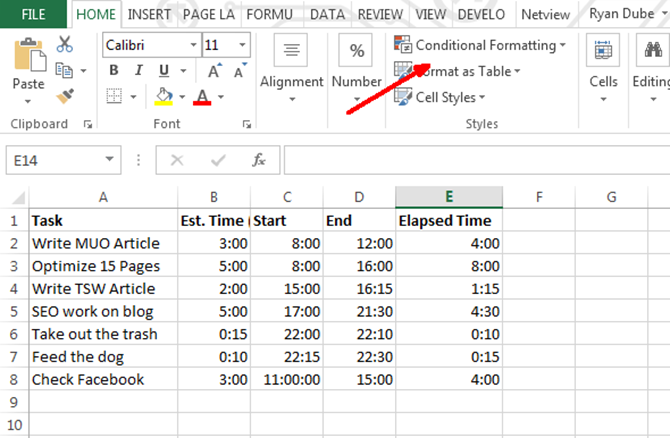
Under Conditional Formatting, there are a lot of options. Most of these are beyond the scope of this particular article, but the majority of them are about highlighting, coloring, or shading cells based on the data within that cell.
This is probably the most common use of conditional formatting—things like turning a cell red using less-than or greater-than formulas. Learn more about how to use IF statements in Excel.
One of the lesser-used conditional formatting tools is the Icon Sets option, which offers a great set of icons you can use to turn an Excel data cell into a dashboard display icon.
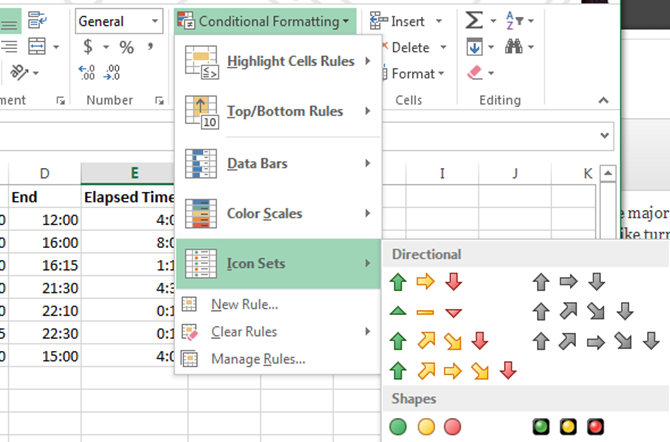
When you click on Manage Rules, it’ll take you to the Conditional Formatting Rules Manager.
Depending on the data you selected before choosing the icon set, you’ll see the cell indicated in the Manager window with the icon set you just chose.
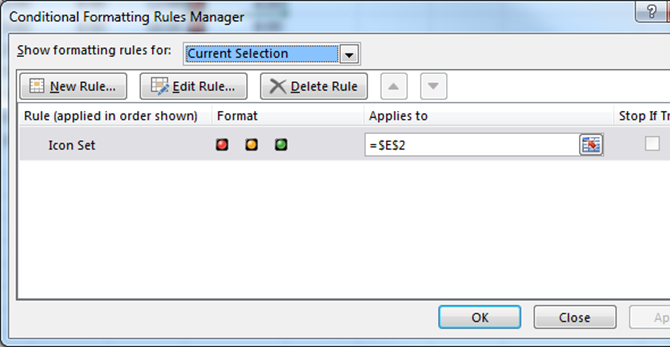
When you click on Edit Rule, you’ll see the dialog where the magic happens.
This is where you can create the logical formula and equations that will display the dashboard icon you want.
This example dashboard will show time spent on different tasks versus budgeted time. If you go over half the budget, a yellow light will display. If you’re completely over budget, it’ll go red.
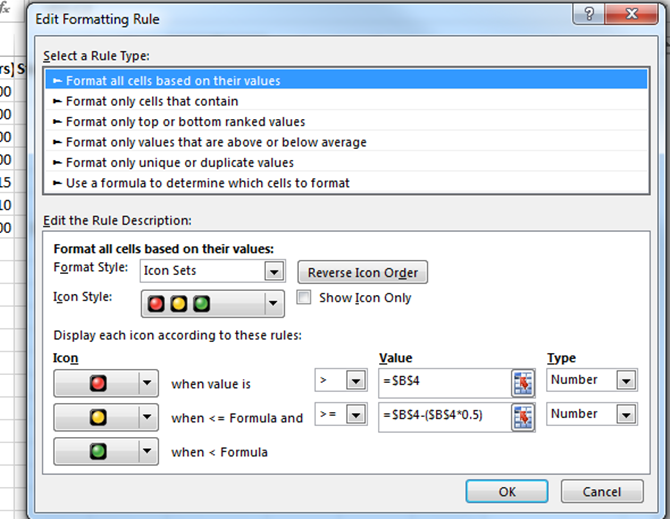
As you can see, this dashboard shows that time budgeting isn’t successful.
Almost half of the time is spent way over the budgeted amounts.
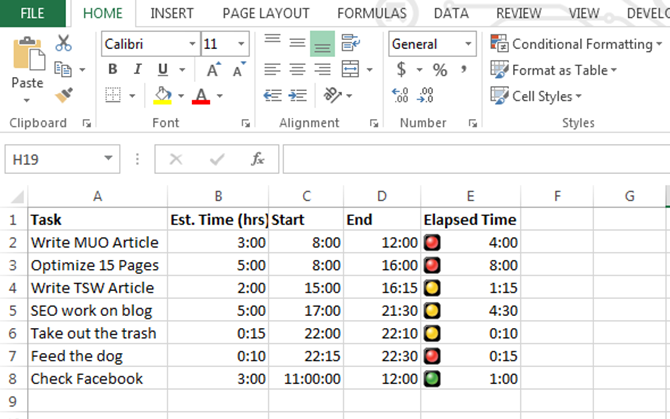
Time to refocus and better manage your time!
If you’d like to use more advanced Microsoft Excel functions, then here are a couple for you to try.
You’re probably familiar with the VLookup function, which lets you search through a list for a particular item in one column, and return the data from a different column in the same row as that item.
Unfortunately, the function requires that the item you’re searching for in the list is in the left column, and the data that you’re looking for is on the right, but what if they’re switched?
In the example below, what if I want to find the Task that I performed on 6/25/2018 from the following data?
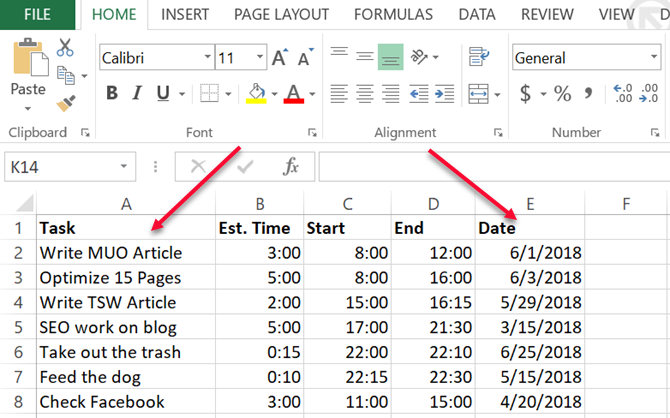
In this case, you’re searching through values on the right, and you want to return the corresponding value on the left.
If you read Microsoft Excel pro-user forums, you’ll find many people saying this isn’t possible with VLookup. You have to use a combination of Index and Match functions to do this. That’s not entirely true.
You can get VLookup to work this way by nesting a CHOOSE function into it. In this case, the Excel formula would look like this:
"=VLOOKUP(DATE(2018,6,25),CHOOSE({1,2},E2:E8,A2:A8),2,0)"This function means that you want to find the date 6/25/2013 in the lookup list and then return the corresponding value from the column index.
In this case, you’ll notice that the column index is "2", but as you can see, the column in the table above is actually 1, right?
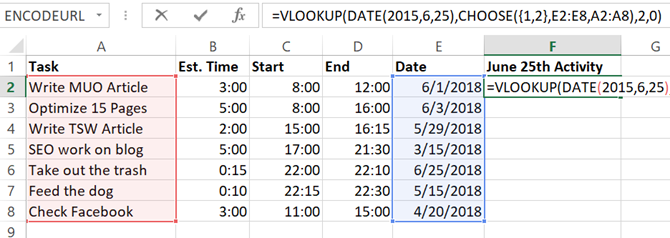
That’s true, but what you’re doing with the "CHOOSE" function is manipulating the two fields.
You’re assigning reference "index" numbers to ranges of data – assigning the dates to index number 1 and the tasks to index number 2.
So, when you type "2" in the VLookup function, you’re actually referring to Index number 2 in the CHOOSE function. Cool, right?

The VLookup now uses the Date column and returns data from the Task column, even though Task is on the left.
Now that you know this little tidbit, just imagine what else you can do!
If you’re trying to do other advanced data lookup tasks, then check out this article on finding data in Excel using lookup functions.
Here’s one more crazy Excel formula for you! There may be cases where you either import data into Microsoft Excel from an outside source consisting of a string of delimited data.
Once you bring in the data, you want to parse that data out into the individual components. Here’s an example of name, address, and phone number information delimited by the ";" character.
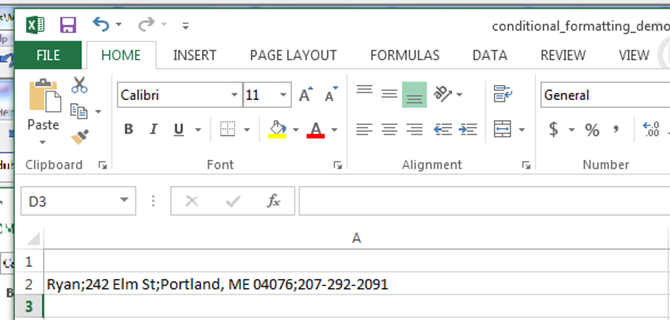
Here’s how you can parse this information using an Excel formula (see if you can mentally follow along with this insanity):
For the first field, to extract the leftmost item (the person’s name), you would simply use a LEFT function in the formula.
"=LEFT(A2,FIND(";",A2,1)-1)"Here’s how this logic works:
In this case, the leftmost text is "Ryan". Mission accomplished.
But what about the other sections?
There may be easier ways to do this, but since we want to try and create the craziest Nested Excel formula possible (that actually works), we’re going to use a unique approach.
To extract the parts on the right, you need to nest multiple RIGHT functions to grab the section of text up until that first ";" symbol, and perform the LEFT function on it again. Here’s what that looks like for extracting the street number part of the address.
"=LEFT((RIGHT(A2,LEN(A2)-FIND(";",A2))),FIND(";",(RIGHT(A2,LEN(A2)-FIND(";",A2))),1)-1)"It looks crazy, but it’s not hard to piece together. All I did is took this function:
RIGHT(A2,LEN(A2)-FIND(";",A2))And inserted it into every place in the LEFT function above where there’s an "A2".
This correctly extracts the second section of the string.
Each subsequent section of the string needs another nest created. Now all you need to do is take the "RIGHT" equation that you created in the last section, and paste it into a new RIGHT formula with the previous RIGHT formula pasted into it where you see "A2". Here’s what that looks like.
(RIGHT((RIGHT(A2,LEN(A2)-FIND(";",A2))),LEN((RIGHT(A2,LEN(A2)-FIND(";",A2))))-FIND(";",(RIGHT(A2,LEN(A2)-FIND(";",A2))))))Then, you need to take THAT formula and place it into the original LEFT formula wherever there’s an "A2".
The final mind-bending formula looks like this:
"=LEFT((RIGHT((RIGHT(A2,LEN(A2)-FIND(";",A2))),LEN((RIGHT(A2,LEN(A2)-FIND(";",A2))))-FIND(";",(RIGHT(A2,LEN(A2)-FIND(";",A2)))))),FIND(";",(RIGHT((RIGHT(A2,LEN(A2)-FIND(";",A2))),LEN((RIGHT(A2,LEN(A2)-FIND(";",A2))))-FIND(";",(RIGHT(A2,LEN(A2)-FIND(";",A2)))))),1)-1)"That formula correctly extracts "Portland, ME 04076" out of the original string.
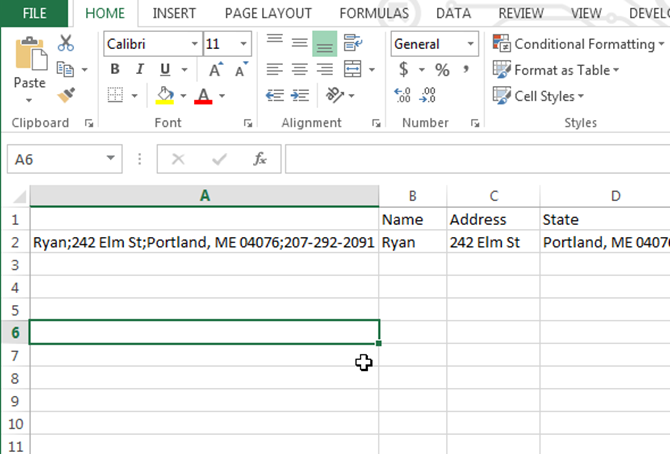
To extract the next section, repeat the above process all over again.
Your Excel formulas can get really loopy, but all you’re doing is cutting and pasting long formulas into themselves, making long nests that still work.
Yes, this meets the requirement for "crazy". But let’s be honest, there is a much simpler way to accomplish the same thing with one function.
Just select the column with the delimited data, and then under the Data menu item, select Text to Columns.
This will bring up a window where you can split the string by any delimiter you want. Simply input ‘;‘ and you’ll see that the preview of your selected data changes accordingly.

In a couple of clicks, you can do the same thing as that crazy formula above… but where’s the fun in that?
So there you have it. The above formulas prove just how over-the-top a person can get when creating Microsoft Excel formulas to accomplish certain tasks.
Sometimes those Excel formulas aren’t actually the easiest (or best) way to accomplish things. Most programmers will tell you to keep it simple, and that’s as true with Excel formulas as it is with anything else.
If you really want to get serious with using Excel, you’ll want to read through our beginner’s guide to using Microsoft Excel. It has everything you need to start boosting your productivity with Excel. After that, make sure to consult our essential Excel functions cheat sheet for more guidance.
Image Credit: kues/Depositphotos
MUO – Feed
https://static1.makeuseofimages.com/wordpress/wp-content/uploads/2021/06/meld-diff-and-merge-tool-latest.png
Writers and programmers often need to compare different versions of the same code or text to keep track of changes. However, figuring out the changes is not a simple task. As a document gets longer, you’re more likely to make errors in comparison.
A file comparison tool helps you compare and merge differences between two (or more) versions of the same file. There are different types of utilities, each tailored for specific types of file formats.
We’ll look at some best file comparison and difference (diff) tools for macOS.
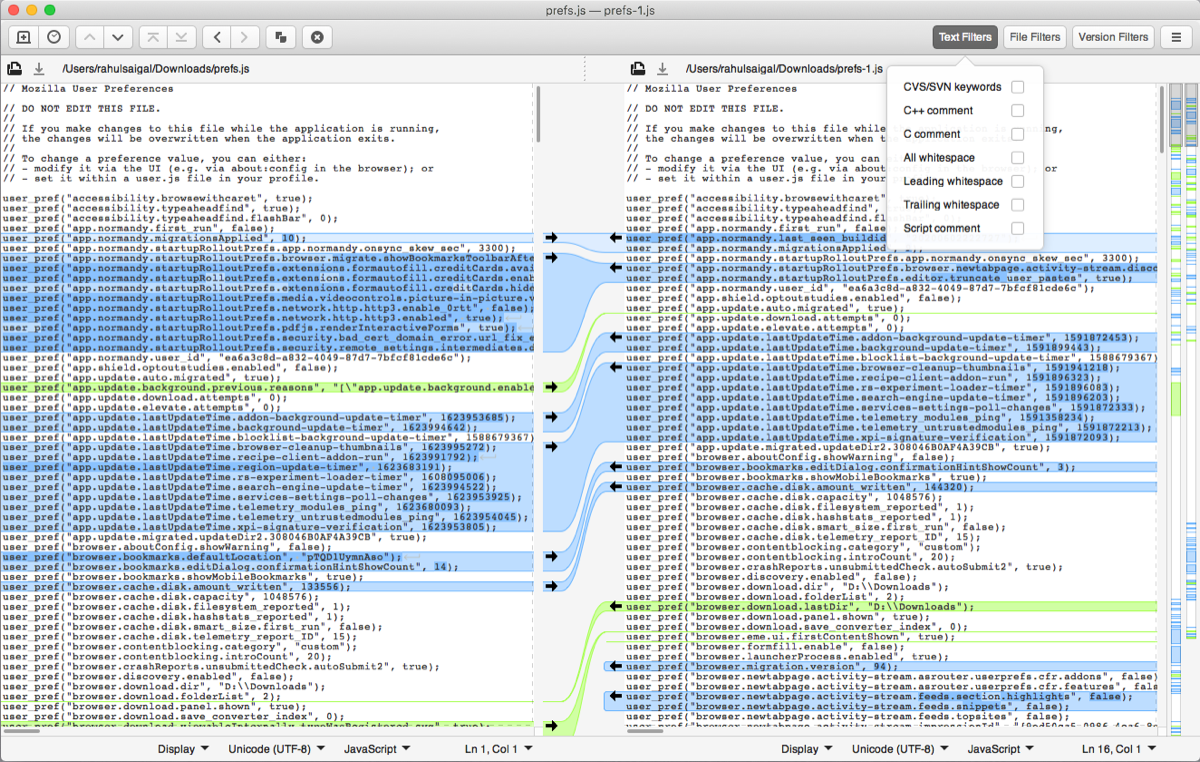
Meld is a simple, cross-platform diff and merge tool. The user interface is intuitive and neatly packs all its functions into a handy menu. It has many customizable settings to make file comparison quick and easy.
On first launch, the app gives you an option to choose a comparison module. To start a comparison, click the File module and select your files from Finder.
Meld will display them side-by-side. Any differences between them appear highlighted to make individual changes easier to see.
On either side of the panels, you’ll see two vertical bars with colored blocks. They give you a bird’s-eye view of all changes, such as inserted, deleted, changed, or in conflict. Click the arrows in a segment to copy or merge a block of one file with another.
Download: Meld (Free)
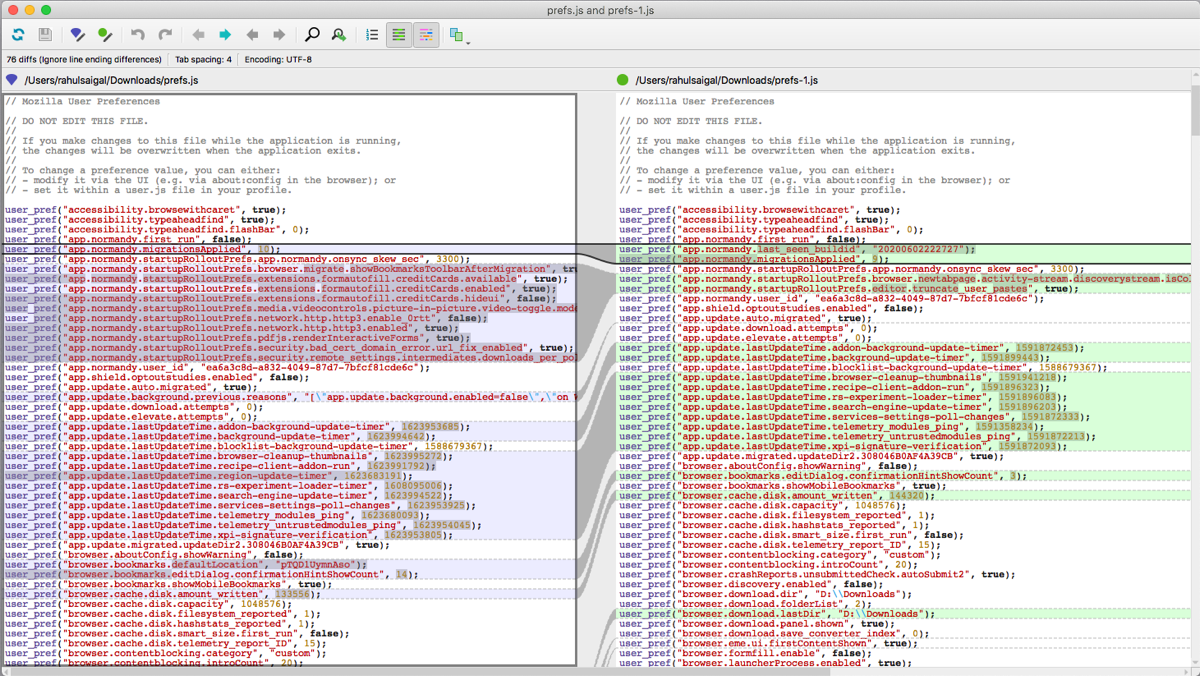
Helix P4V is a cross-platform, enterprise version control software used to compare and merge source files, web pages, manuals, OS code, and more. P4V is the client for the Helix core server that hosts all your data and resides in a depot. You open the files and edit them in your workspace.
When done, submit the modified file back to the shared repository or depot, where it keeps track of all the file revisions. P4V integrates with the P4 diff and merge tool. The purple icon and its color scheme highlight the input file, while the green icon and its color scheme highlight the output file.
P4Merge displays files side-by-side, with the center as a base file. This allows you to compare two files with a base file to find differences and select the text you want in the merged file. To navigate, click the Previous or Next buttons.
Download: Helix P4 Diff and Merge (Free for five users and 20 workspaces)
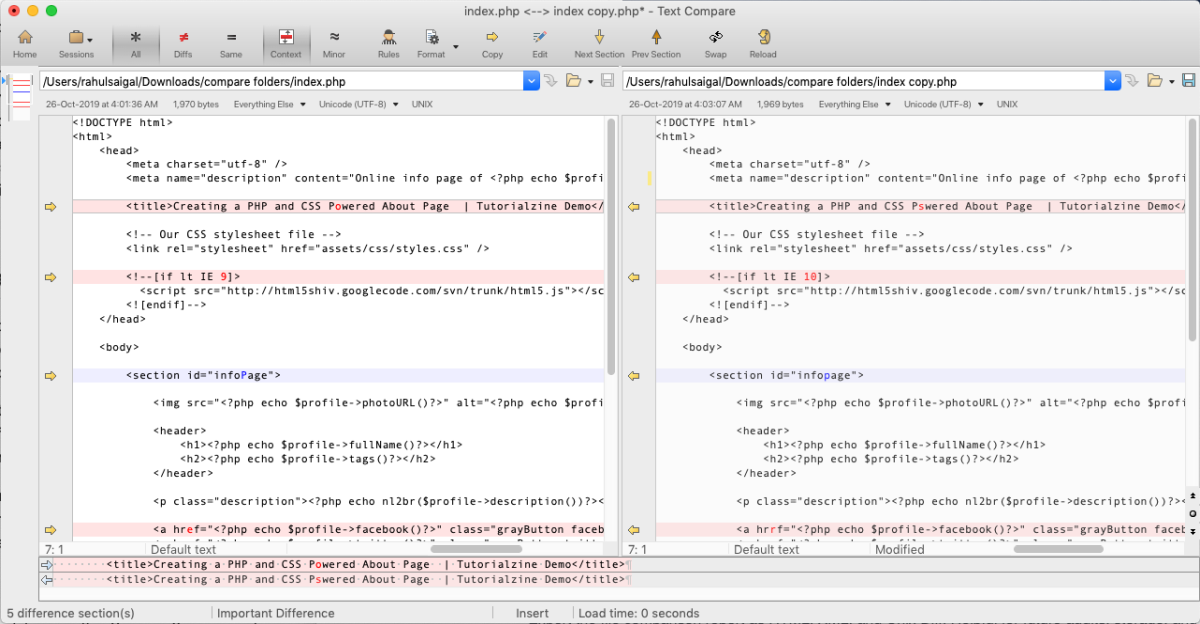
Beyond Compare is a comprehensive utility to compare and merge various file types and folders. The app tries to maintain a balance between features and performance with an easy-to-use interface and colorful buttons. On first launch, choose the comparison module for Text, RTF, Hex, MP3, Tables, and more.
Every comparison task begins with a Session. You can customize and save any session as Workspace. Simply load the workspace, and Beyond Compare will also load all your sessions with the same configuration and tabs.
The app will display your files side-by-side. It uses red text for highlighting important differences and blue for insignificant changes. You can adjust these colors to suit your preferences.
The overview thumbnail on the left pane displays a visual map of colors. To navigate, use the Next and Previous buttons to step through all your differences. Then, use the arrow buttons to merge your files. Click the Save button located at the right of the window to save your file.
Download: Beyond Compare ($30 Standard | $60 Pro | Free trial available)
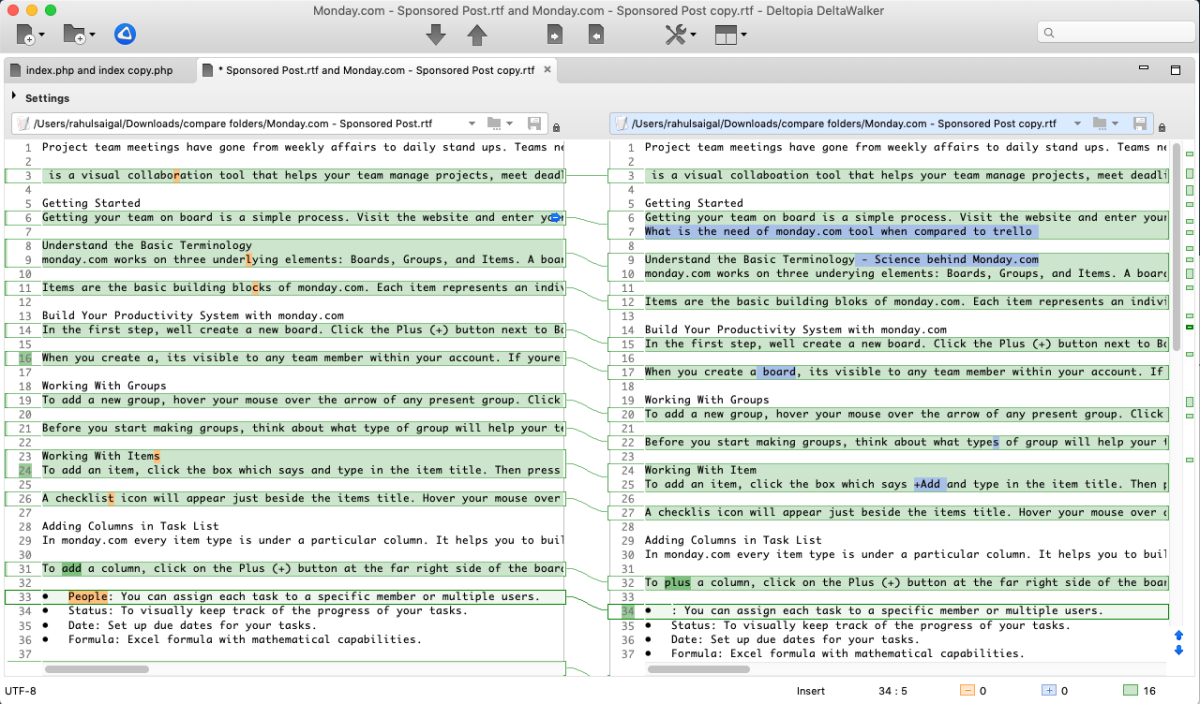
DeltaWalker is a cross-platform visual diff and merge tool. The interface is intuitive, with just a few menu buttons. It relies more on visual parameters to help you find differences. Out of the box, it supports Office files, Java archives, ZIP, XML, PDF, and more. Speaking of which, we’ve covered how to compare two Excel files using other methods.
Click the Browse button in the entry field to bring up a File Open dialog box. On the other side, you can either open a local or remote file via SFTP, HTTPS, WebDAV, Dropbox, or Google Drive.
The app uses colors to denote the changes in blocks as inserted, deleted, changed, and in conflict. You’ll see connecting lines that joins together related blocks to simplify the results.
The vertical color strip on the right panel shows a summary with a scaled-down visual map of all differences. Click the arrow button (which appears when you hover your mouse) to merge your files.
Download: DeltaWalker ($40 Standard | $60 Pro | Free trial available)
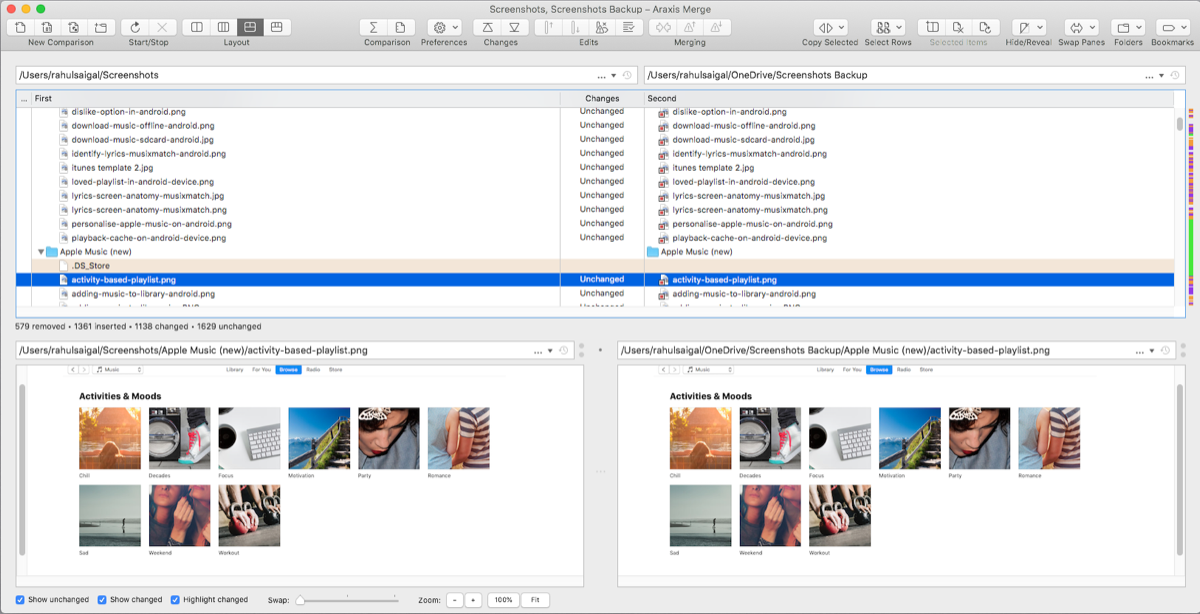
Araxis Merge is a complex diff and merge tool. It works with many file formats, including Office files, PDF, XML, HTML, Binary, and source code files. This makes the app suitable for various creative professionals and use cases.
Click the Browse button to open your file. Araxis Merge uses text extraction filters and formatting tools to help you see changes more clearly. Go to Preferences > File Comparisons > File Types to configure the filters for various kinds of files.
Thin overview strips next to the scroll bar show the position of changes. The status bar shows you a summary of changes that are inserted, removed, changed, and deleted. The built-in plugin system gives you access to files located in Git, SVN, and Perforce Depot.
There are two layout options: vertical and horizontal. They both work with two- and three-way file comparison modes. Use the Previous or Next buttons (or shortcuts) to navigate through the file. Additionally, click the small merging button on each block to copy, replace, or merge files.
Download: Araxis Merge ($129 Standard | $269 Pro | Free trial available)
There are many reasons to use a file comparison tool. A software developer might need syntax highlighting and export features. A writer may prefer a more visual diff tool to compare text. The apps discussed here cover every use case. Give them a proper trial to see which one fits your needs.
If you’re using the excellent text editor Notepad++, then you can compare files easily with a plugin. It’s feature-rich and fits both casual users and programmers.
MUO – Feed
https://assets.amuniversal.com/ef5645f0a0e201396138005056a9545d
Thank you for voting.
Hmm. Something went wrong. We will take a look as soon as we can.
Dilbert Daily Strip
https://www.buckeyefirearms.org/sites/buckeyefirearms.org/files/styles/slideshow/public/field/image/Gun%20Pile.jpg?itok=0S9sTixg

The efforts of officials to confiscate military-style firearms in Massachusetts ran into trouble recently when armed militia groups confronted a government raid to seize a stockpile of guns and ammunition and arrest leading anti-government activists rumored to be in a small town outside of Boston.
The government forces were initially met by a small number of militia members in Lexington. After their show of force, the militia leader ordered his men to stand down and allow the government’s troops to pass. They were in the process of dispersing when a shot rang out. No one is sure just who fired that shot, but in response government troops opened fire, killing eight and wounding several others before their officers could regain control of the situation. Government forces then proceeded west towards their original destination of Concord, Massachusetts.
At Concord, the government troops spread out through the community searching for banned goods and the individuals they had been instructed to arrest. One group headed toward William Barret’s farm where it was reported that a stockpile of guns and ammunition was being collected. Meanwhile, some prohibited items were found in the town and set on fire in a vacant lot. However, the fire soon spread to a nearby building and the resulting smoke led some militia leaders that had assembled their men in the area to believe the town was being deliberately burned down. They began advancing and confronted a group of government troops at a bridge on the north side of the town. A brisk exchange of gunfire resulted in about a dozen casualties and government forces retreating back towards the center of town.
At this point, the raid’s leaders decided it would be best to return to Boston rather than continuing on their mission. During the subsequent retreat, an estimated seventy troops were killed and about two hundred were wounded as thousands of militiamen from the area rushed to confront the retreating government forces.
Following the abortive raid, an investigation was launched into why it had failed. The raid had been planned in the utmost secrecy, with the troops and leaders learning of their mission only at the last possible moment. Still word leaked out, probably by someone that overheard the planning of the raid at the governor’s mansion. Knowledge of the potential raid quickly spread to militia leaders but the exact target of the raid was not known. The individual that leaked the information about the raid was never identified.
This most recent raid was part of a trend that started last year when a law was passed banning the importation of military-style firearms and ammunition into the state. Subsequently, government forces began conducting warrantless searches for guns and ammunition. A successful raid was conducted on September 1, when a stockpile of ammunition was seized from a site about six miles northwest of Boston. A similar effort to seize ammunition stockpiles occurred in Williamsburg, Virginia. Rumors quickly spread that the government was deliberately trying to deny citizens the ability to acquire ammunition. Hoarding and shortages soon followed.
These initial successful efforts led the Massachusetts and Virginia governors to order further raids. A second attempt to seize illegal guns and ammunition was aimed at the Salem community. This one failed when local citizens learned of the raid and took efforts to block roads and bridges, preventing government officials from reaching the town.
Gun control efforts in Massachusetts increased in response to protests in Boston resulting from raising taxes and harsh treatment by government officials. This latest series of protests turned violent a few years ago when government officials opened fire on a crowd, killing five, including one black man. A couple of years later another group of protesters seized control of an embargoed shipment of goods pending payment of import taxes. Although the protest was non-violent, several thousand dollars in goods were destroyed. In an effort to restore order, Massachusetts’ governor imposed martial law in the area immediately around Boston and ordered the confiscation of firearms and ammunition.
In response to the governor’s action, Massachusetts gun rights leaders pointed to a resolution that was voted on almost ten years ago that stated every citizen was entitled to possess a firearm for their own personal protection and to defend the state from outside attack. They said that the government’s latest efforts fly in the face of long-standing tradition that people have the right to defend themselves.
[Author’s Note: You probably have not heard about these incidents in any of the major news outlets. However, they all happened, just not recently. Instead they occurred in the late eighteenth century and involved the events surrounding the Boston Massacre (1770), the Boston Tea Party (1773), and the Battles of Lexington and Concord (1775). Even then, gun control was used in an attempt to control the rights of citizens to protest government actions.]
Buckeye Firearms Association
https://cdn.thewirecutter.com/wp-content/media/2021/06/52-things-thermacell-2048px-0115-3×2-1.jpg?auto=webp&quality=60&width=630&dpr=2

I hate bugs.
I hate them so much that when my husband suggests having dinner outside or playing a lawn game, I immediately start to wonder about the swarms of mosquitoes that will attack me.
How about a card game inside instead?
But ever since we started using Thermacell devices, I have happily said yes to the outdoors more often.
Wirecutter: Reviews for the Real World
https://assets.amuniversal.com/2f2280d0b1d401396577005056a9545d
Thank you for voting.
Hmm. Something went wrong. We will take a look as soon as we can.
Dilbert Daily Strip
https://s3files.core77.com/blog/images/1197497_81_109313_WaOdEJNif.jpg
After years of living in NYC, Jean and Joe moved to Minneapolis, where they could afford to build a house. But one thing that wasn’t in their budget was the freestanding garage required by local housing ordinances. They took bids from contractors, and the price for building a garage from scratch came in at $30,000. Their story was captured by Fair Companies in the video below.
To summarize the garage story: After doing some research, Jean found a company in Canada that manufacturers Quonset huts to custom sizes. While she doesn’t mention the company by name, I looked at several fitting that description and believe they went with Mississauga-based Metal Pro Buildings.


MPB cranks out prefabricated sheet metal arches to whatever dimensions you need. They’re shipped to you in pieces, and all you need to do is bolt each arch together, stand them up, bolt them to each other, then bolt the end pieces on.



By going with the prefabricated Quonset hut approach and DIY assembly, Jean and Joe paid just $6,000, versus the $30,000 cost of a stick-built garage. (One thing they don’t mention in the video is the cost of the concrete slab, which they apparently did have in their budget.)



While the "shotgun"-style layout dictated by their plot seems inconvenient, I’m amazed that you can get a two-car garage for six grand. If you’re seeking a similarly cheap outbuilding, you can check out MPD’s different Quonset models (it looks like Jean and Joe went with the S-Series, but there are five styles total) here.

Core77
https://www.thefirearmblog.com/blog/wp-content/uploads/2021/06/hr1-180×180.jpg
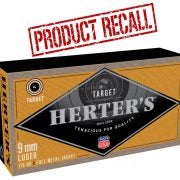 TFB recently reporting on the announcement of a safety recall for certain lots of Winchester and Browning 9mm ammunition. The 115-grain rounds in question, manufactured for these brands in East Alton, Illinois by the Olin Corporation, are subject to a factory defect causing the powder to burn improperly. This can cause what is known as […]
TFB recently reporting on the announcement of a safety recall for certain lots of Winchester and Browning 9mm ammunition. The 115-grain rounds in question, manufactured for these brands in East Alton, Illinois by the Olin Corporation, are subject to a factory defect causing the powder to burn improperly. This can cause what is known as […]
The post Another Recall: Herter’s 9mm Lots Added to List of Defective Ammo appeared first on The Firearm Blog.
The Firearm Blog
https://i.kinja-img.com/gawker-media/image/upload/c_fill,f_auto,fl_progressive,g_center,h_675,pg_1,q_80,w_1200/3f215c88231ce9686e4b107e68becf22.jpg
My sustainable homestead is evolving—and the new addition to the ever-growing project involves using rain barrels to provide my chickens with drinking water, irrigate my garden, and keep my compost pile moist.
Luckily for me, my local municipality teamed up with our state college to offer residents classes and incentives to help grow our community’s conservation effort (you can check with your local government to see if they offer anything similar). Through the program, I was able to purchase a 55-gallon rain barrel for just $37—a deal so good I opted to purchase three barrels. The barrels were guaranteed to be food-grade, which meant I avoided the toxic residuals that might have been lurking in any old barrel. Instead, my barrel had been used exclusively to store juice, so it was actually designed to withstand both the pressure and weight of 55 gallons of liquid, which weighs roughly just under 500 pounds.
The sweet juice residuals meant I needed to clean the barrel out with a solution, though. You can use a solution of one ounce of bleach to five gallons of water or, as I did, opt for a vinegar and baking soda alternative. However you get the job done, you’ll want to make sure the barrel is fresh and clean before you start collecting water in it.
Here are a few things I’ve learned throughout the process:
The build itself is rather simple: Rain barrels have inlets into which you direct a water source—you can direct the water from your gutter system by modifying your downspout to pour directly into the inlet, for example. Add another hole toward the top of the barrel for overflow and plan to direct that water away from your foundation—or into another barrel.
Next, you’ll need to cut a hole toward the bottom of the barrel and install a spigot. From the spigot, you can use a garden hose to direct the water to wherever you want it to go. How high you place the barrel will determine how much pressure you are going to get.
G/O Media may get a commission
Lifehacker